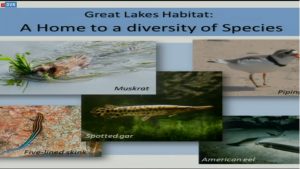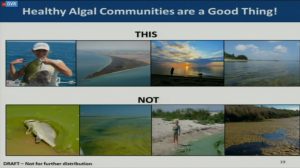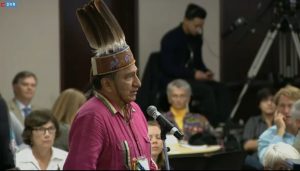
Day two of the Great Lakes Public Forum brought more insight into the progress of both Canada and the US in their efforts to implement the Water Quality Act, and shed some light on their combined efforts towards greater inclusion – both of First Nation and Native American tribal voices, and of the input of the greater public. Some highlights from the day: Susan Humphrey, Associate Regional Director General of Environment Canada and Tinka Hyde, Division Director, Region 5 Water Division, US EPA who focused on the new phosphorous reduction targets for the two countries. Although algae growth is an issue throughout the lakes, Lake Erie was the lake causing the most concern from both governments, as the algal blooms there have increased, rather than decreased in recent years. New targets have been officially adopted by both countries this year, to reduce phosphorous loads in the western basin 40% by March of 2017.
The next presentation was from Mark Mattson, Founder and President of Lake Ontario Waterkeeper, a former environmental lawyer who gave up his practice to do water advocacy full time. His overall message was one of caution, to celebrate the progress being made, without forgetting the folks who are directly effected by the very real, even dire, battles that continue to be fought in the basin- like the people effected by the algal blooms in Toledo, Point Pelee and the fight against the disposal of nuclear waste along the basin’s shorelines. After a short break came speaker Neil Patterson Jr., a member of the Tuscarora Nation and Director of the Tuscarora Environment Program. Mr. Patterson told stories that gave insight into the First Nation’s relationship to the Water Quality agreement. One of the stories he told was about a traditional Thanksgiving address, that recalls a prophecy handed down for generations, in which the trees die from the top down, the water becomes undrinkable, and strawberry plants refuse to fruit. The teaching includes instruction to not be fearful, but to think of the next generations and to put collective minds together as one in order to solve the problem. He drew a parallel between that story and the agreement of 1972 and the work that has happened since. He also held up a traditional two-row wampum belt that symbolizes peace, trust and friendship, and stated that the belt reminds him of the agreements that call for justice, and greater consciousness about the interconnectedness of the natural world.
Susan Humphrey, Associate Regional Director General, Environment Canada, Laurie Nordstrom Assistant Regional Director of Ecological Services, US Fish and Wildlife Service spoke next to the issue of restoring native species and wildlife habitats throughout the basin. This presentation gave an overview of the importance of sustaining our rich native species and habitat, and description of the process of how organizations will work together over the next year to create informed targets for progress. 
A Q&A session brought Chief Dean Sayers from the Batchewana Nation to the mic, who asked why the first nations flags were not on the table along with the American and Canadian flags. He said he was concerned that fallacies were being promoted about the jurisdiction of the Great Lakes- and that he didn’t remember when Canada or the US gained the right to govern and manage the lakes. He asked why his people were not being consulted as part of the decision making processes around policy to manage the water, and reminded those in the room, that first nations have the real jurisdiction over the lakes. No one from either government responded to this comment at the time. Later on, after other questions on other subjects, he spoke again, and was followed by a fellow member of the Batchewana Nation, who emphasized, again, the need for the First Nations voice to be at the table. This time, there was a response. Tim Eder, CEO of the Great Lakes Commission recognized that there was a conversation happening this year at the forum that was expanded from previous years – going beyond the hard science, and including multiple, sometimes conflicting, points of view as well an acceptance that “we don’t have all the answers and still have a ways to go.” Both Michael Goffin and Cameron Davis then made moving personal statements about their appreciation for the First Nations voice, a desire to continue to build a relationship with First Nations and Tribal leadership, and an appreciation for the multi-generational approach to looking at the issues of the Great Lakes that they bring to every discussion.
Afternoon presentations included the subjects of Understanding the Impacts of Climate Change on the Great Lakes, Addressing the threat of Invasive Species (identified as the worst current threat to the health of the lakes), a presentation on the heritage of the Metis Nation of Ontario and, finally, a Q and A session lead by the International Joint Commission encouraging public comment and input on the progress of governments in relation to the Great Lakes Water Quality Agreement. The overall tone of the day was one that encouraged continued collaboration between organizations and greater involvement of private citizens. Nearly every speaker made a call to action towards the end of their presentation, asking for increased engagement based on the knowledge they were sharing.
Tomorrow, the conversation will expand to include hundreds of young people around from around the basin who have questions, and even some solutions about and for Great Lakes problems. Though we won’t be live-streaming the conference tomorrow, we will be attending, and doing some filming and interviewing to bring back a youth perspective on the forum.







